New Orleans Cotton Exchange Building
Introduction
Text-to-speech Audio
This building was constructed in 1921 to house the New Orleans Cotton Exchange, which was formed in 1871. The exchange's original building was located on the corner of Carondelet and Gravier Streets. It remained on that corner, but in a series of three difference buildings, until the exchange ceased operations in 1964. This building, which now houses an AC Hotel by Marriott, was designated a National Historic Landmark and placed on the National Register of Historic Places in 1977.
Images
The New Orleans Cotton Exchange existed at this intersection from 1871-1964. The last building that was its home is now a hotel.
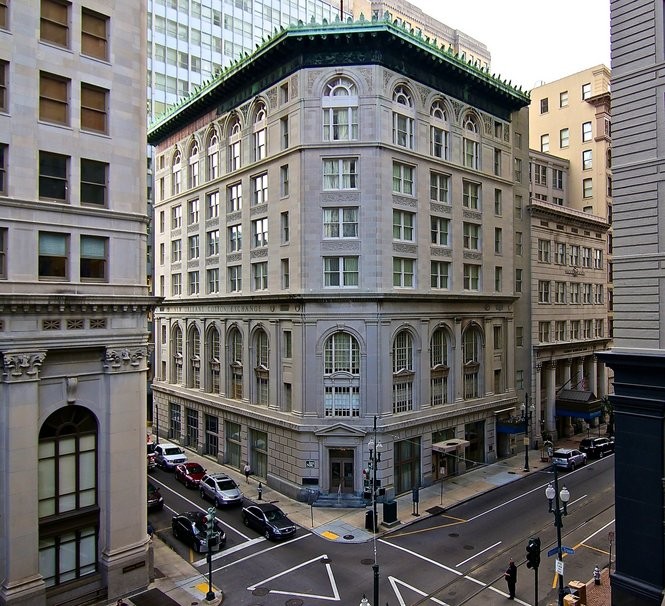
This ornate building was the Cotton Exchange's second home from 1883 to 1920 when it was demolished due to structural problems.
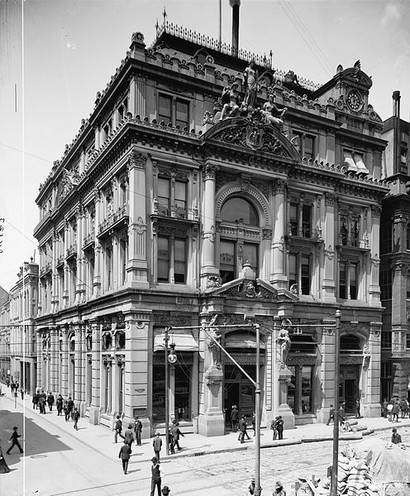
The massive vault used by the Cotton Exchange still sits in the basement of the building.
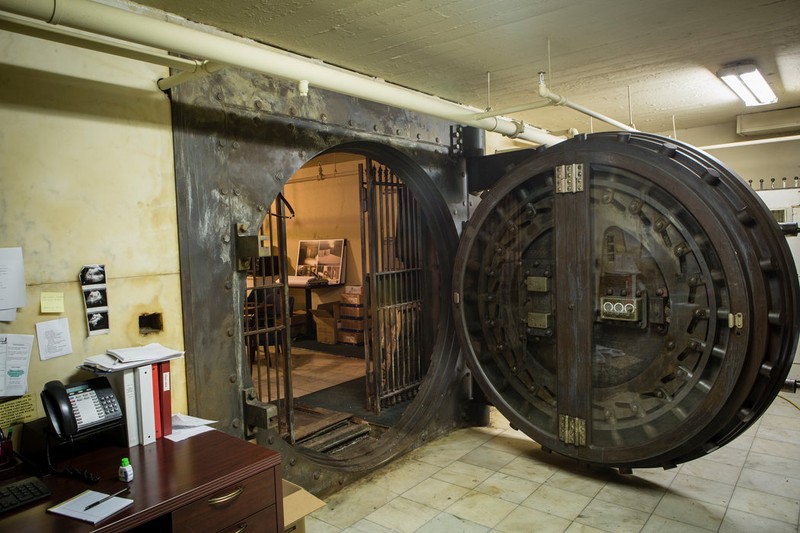
Men trade in cotton futures on the floor of the Cotton Exchange in the 1940s.
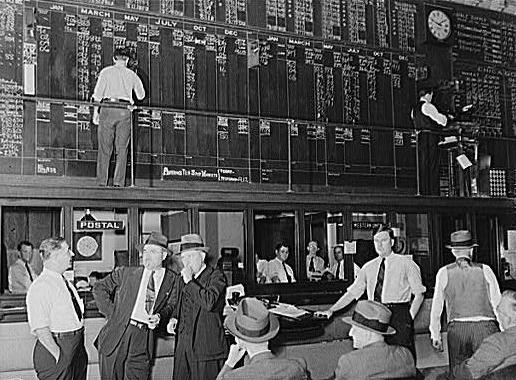
"A Cotton Office in New Orleans," by Edgar Degas. 1873
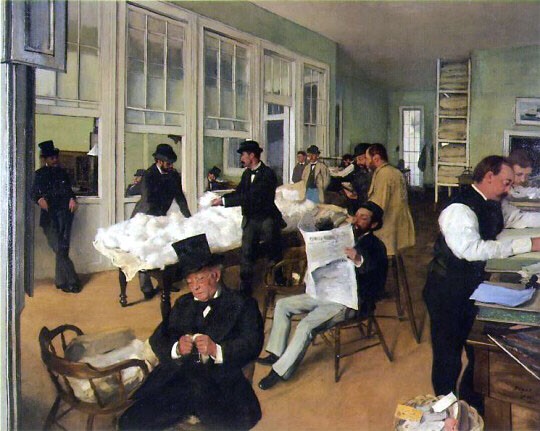
Backstory and Context
Text-to-speech Audio
The cotton industry boomed (again) in the wake of the Civil War and New Orleans played an integral role in enhancing that trade to the world market. More than 6.1 million bales of cotton moved through New Orleans between 1866 and 1872, which accounted for roughly one third of the total United States cotton production.1
By 1870, over one third of all cotton produced in the U.S. passed through the port of New Orleans. That year, the city of New York launched a cotton exchange. This moved spiked fears among cotton merchants of a buyers' market in the cotton industry. In response, the New Orleans Cotton Exchange was formed in 1871 to stabilize the cotton pricing system, offer a place for centralized trading, standardize the classification system for cotton, and facilitate purchases between buyers and sellers. It was originally housed in a modest building, with Colonel Henry G. Hester acting as the organization's first Secretary. Hester introduced the practice of futures trading.
By 1879 the New Orleans Cotton Exchange transitioned to a more modern idea of exchange known as "futures." Although the idea was initially was met with resistance, cotton exchange leadership went ahead with the plan and then adopted regulations that governed the sale of future cotton stocks. As a result, the NOCE enjoyed further growth and expansion.2
During his 1873 visit to New Orleans, renown French artist Edgar Degas, painted, "A Cotton Office in New Orleans." For years it was believed that setting for the painting was the Cotton Exchange. However, recent research revealed that the featured office was actually one located nearby on "Factor's Row."
The New Orleans Cotton Exchange soon outgrew its original quarters, and a larger building was constructed in 1883 in the Second Empire style. This ornate building housed the Exchange until it was deemed structurally unsafe in 1916 and then demolished in 1921. Two of this building's original sculptures are now housed at the entry to the Weiblen Marble and Granite Works on City Park Avenue.
The Exchange’s third and final home was built at 215 Carondelet in 1920. It was designed by architects Favrot and Livaudais in the style of a Renaissance palazzo.
By the mid-20th century, changing market conditions and the overall decline of Southern cotton production had reduced the need for a cotton exchange in the city. The Exchange sold the building in 1962. Since then, the building has housed a series of hotels. After receiving a $12 million renovation, the building opened as the AC Hotel Bourbon in late 2013. Many of the building's original marble walls and terrazzo floors remain in place. The hotel's guestrooms closed in November, 2016, due to “construction issues,” but the lobby and bar remained open.
Sources
1 Edward King, The Southern States of North America: A Record of Journeys in Louisiana, Texas, the Indian Territory, Missouri, Arkansas, Mississippi, Alabama, Georgia, Florida, South Carolina, North Carolina, Kentucky, Tennessee, Virginia, West Virginia and Maryland, (London: Blackie & Son, 1875), 51.
2 Tuffly L Ellis, “The New Orleans Cotton Exchange: The Formative Years, 1871-1880,” The Journal of Southern History 39, no. 4 (November 1973): 548-563, http://www.jstor.org/stable/2205967.
Other sources used, but not directly cited:
Kolb, Carolyn. "Glory Days of the Cotton Exchange." My New Orleans. January, 2011. Accessed January 20, 2017. http://www.myneworleans.com/New-Orleans-Magazine/January-2011/GLORY-DAYS-OF-THE-COTTON-EXCHANGE/
White, Jaquetta. "Former Cotton Exchange building becomes 'lifestyle' hotel." The New Orleans Advocate. January 3, 2015. Accessed January 20, 2017. http://www.theadvocate.com/new_orleans/news/business/article_5eed6109-0de3-5588-8c80-0485f53ca299.ht...
"New Orleans Cotton Exchange Building." Old New Orleans. Accessed January 20, 2017. http://old-new-orleans.com/NO_Cotton_Exchange.html
"New Orleans Cotton Exchange To Close Today After 93 Years." New York Times. July 9, 1964. Accessed January 20, 2017. http://www.nytimes.com/1964/07/09/new-orleans-cotton-exchange-to-close-today-after-93-years.html?_r=...
"Commercial and Financial Review". The Daily Picayune. New Orleans. 29 November 1870.
"Commercial and Financial Review". The Daily Picayune. New Orleans. 21 February 1871.
L. Tuffly, Ellis (November 1973). "The New Orleans Cotton Exchange: The Formative Years, 1871–1880". The Journal of Southern History. 39 (4): 545–64.
Brown, Marilyn (1994). Degas and the Business of Art: A Cotton Office in New Orleans. University Park: Pennsylvania State University Press. p. 21.
